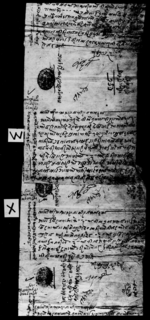A copy of a rukkā from King Rājendra authorizing Syāmadhara Kaṭhāyet to enjoy one pāṭhī of jhusyā from each household for his ritual roles at Jumlā's Tripurasundarī (VS 1901)
ID: K_0093_0002W
Edited and
translated by Ramhari Timalsina
in collaboration with
Yogesh Budathoki
Created: 2021-03-24;
Last modified: 2021-07-26
For the metadata of the document, click here
The accompanying edition, translation/synopsis and/or commentary are available under the terms of the Creative Commons Attribution-ShareAlike 4.0 International License
Abstract
This copy of a rukkā from the king, who according to the date must have been Rājendra, confirms Syāmadhara Kaṭhāyet's right to enjoy one pāṭhī of jhusyā from each household for his ritual duties at Jumlā's Tripurasundarī. This confirmation of his appointment was issued in accordance with a document sent by Subbā Rudravīra Sāhī in VS 1874.Diplomatic edition
[1r]
1श्रीत्रिपुरासुंदरीदेवी1[Unknown seal] 1[?]2सकलवमोजींनकल्दुरुस्तछ1१३नं1ज्वकपतेज1
2स्हीना:रा.वीष्नु
3स्हीनौसीव:1स्वस्तिश्रीमन्माहाराजाधीराजकस्यरुक्का¯¯¯ ¯¯¯ ¯¯¯
2आगेस्यामदरकठाये़तकेजील्लैजुमलात्रीपुराकोटदरा¯ ¯१¯
3कोछरीसमातीतेरावावुवराजुदेषिषाईआय़ावमोजीम
4दराभरकोघरहीसुस्यापाथी१षानुभंन्यासुव्वारुद्रवीर
5साहीले७४सालमादस्षत्गरीदीया़वमोजीम्हामी
6वाटपनीथामीमोहरगरीवक्स्यौंअवऊप्रांन्तपनीअ
7घीदेषिगरीआय़ाको¯ ¯१¯कोछडीसमातीटह
8लगरीपुजाहारीकोअह्राय़ोमानीअधीदेषिआ
9जस्मषाईआय़ाकोपाथीषाईवश्न्याकामगरईती
10सम्वत्१९०१साल्मीतीजेष्ठवदी१०रोज[?][?]1सकलवमोजींनकलदुरुस्तछभनीस्हीछापगर्नेथानी
2भानुभक्तपाध्यातीपकोट्1स्हीभानु
2भगतपा
3ध्याकोट्गाउ
Translation
[1r]
The glorious goddess Tripurasundarī (text: tripurāsuṃdarī) — 1
[Unknown seal]
The copy is true to the original.
No. 13 1
Attested 82
Signature of Nā. Su.3 Vīṣnu
Signature of Nau.4 Sīva
Hail! A rukkā of the supreme king of great kings
Following a daskata issued by subbāRudravīra Sāhī in the year [VS 18]74 stating: “In keeping with the fact that your ancestors6 carried the staff7 of -1- (i.e. the glorious goddess Tripurasundarī8 ) located in the Tripurākoṭ subdivision of Jumlā district and enjoyed [remuneration for the same], we told you to enjoy 1 pāthī of jhusyā9 from each household of the subdivision”, we , too, hereby maintain [the arrangement] and issue a lālamohara [to that effect]. Do service by carrying the staff of -1- (i.e. the glorious goddess Tripurasundarī), as has been done from earlier times, obey the orders of the priest10 and enjoy the pāthīs [of jhusyā] as has been customary.
The 10th day of the dark fortnight of Jyeṣṭha in the [Vikrama] era year 1901 (1844 CE). Auspiciousness.
The local man of standing Bhānubhakta Pādhyā, [a resident of] Tīpkoṭ, signing in attestation that the copy is true to the original
Signature of Bhānubhagata Pādhyā, [a resident of] Koṭ village
Commentary
For more information about the temple of Tripurasundarī see the commentary of K_0093_0002C.

